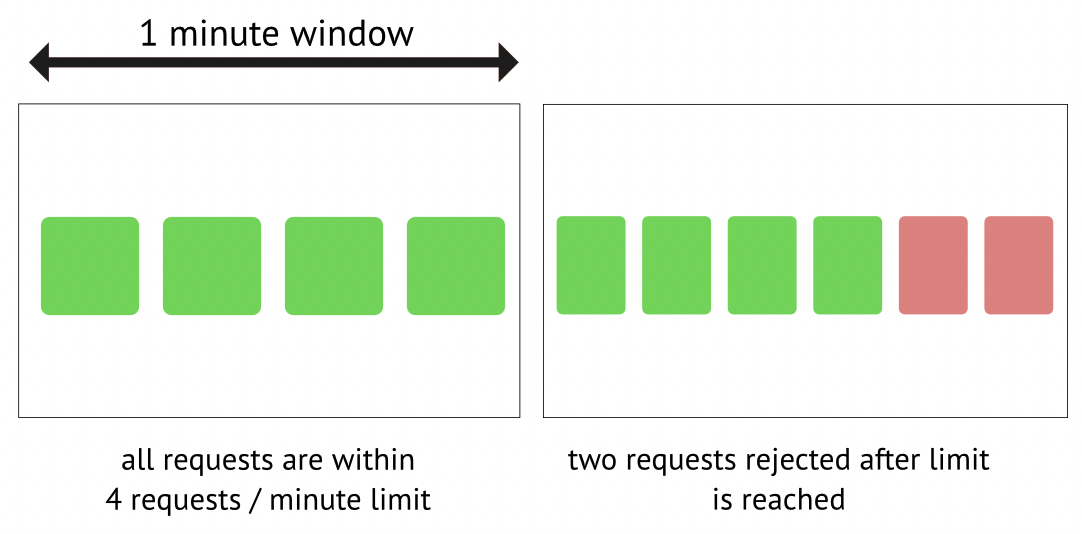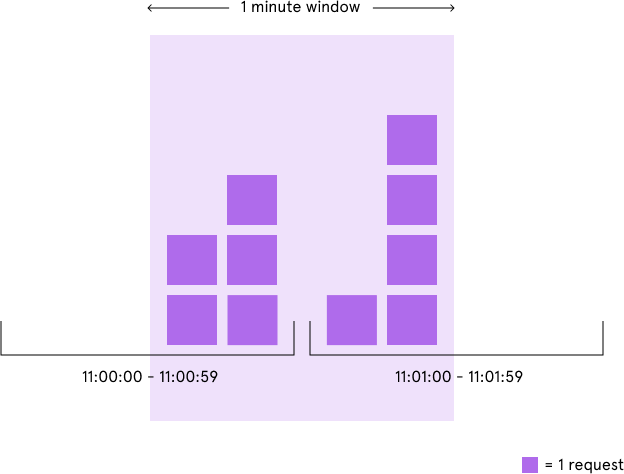There are various methods to implement a rate limiter. Here, I have devised two solutions. First, set up a rate-limiting middleware for routing. Second, establish a proxy, such as Nginx.
I have only implemented a middleware, as configuring both solutions would be resource-intensive for me. Implementing a middleware can be more challenging than configuring plugins like Nginx, Envoy, and Kong, so I prefer to take on the more difficult task.
There are various algorithms available for achieving rate limiting. I have opted for two classical approaches: fixed window and sliding window. As I employ Redis for the counter, and distributed Redis can be quite complex, I have decided to use a single-instance Redis. I assume there are distributed service nodes connected to this single Redis node.
Note: The endpoint limit is registered before the account limit. Once the endpoint limit is exceeded, the account limit won't be triggered.
Limit by a fixed window start from first request comes.

Since using a "get-then-conditional-set" approach might lead to a race condition, let's consider a scenario where A and B represent two different servers in our cluster. If an account sends two requests simultaneously and these requests are dispatched to A and B servers concurrently, a race condition could arise.
// assume limit value is 5
A: get->4
B: get->4
A: incr->5
B: incr->5
To mitigate this issue, we can employ a Redis lock, the WATCH command, and a Lua script. Given that writing Lua scripts is more straightforward to implement, I have chosen this method.
Followed by the vedio: rate limit using redis
The last one is using a sorted set. Multiple sorted set commands can be grouped together using $redis.multi to execute them atomically, avoiding race condition scenarios.
The specific idea is:
- Use a sorted set to store all timestamps.
- When a request comes in, use
ZREMRANGEBYSCOREto discard keys outside the time window. - Retrieve all remaining elements in the sorted set using
ZRANGE(0, -1). - Add the current operation using
ZADDand extend the TTL of the sorted set. - Calculate the total number of elements in the entire sorted set to determine the number of accesses.
- Ports availible: 8080, 6379
- Docker installed
- Go installed (to run the test scripts)
limiter config is located at config/limit_config.yaml folder. In struct of
AccountLimit: # limit for each account
Duration: 60s
Value: 10 # request count
LimitType: 0 # {0: sliding window, 1: fixed window}
EndpointLimit: # limit for each endpoints
Duration: 60s
Value: 11
LimitType: 0
Since the config is not hot reload. Use docker compose up again for reload the config for testing.
make compose_up
make compose_downTestcases are under test folder, 4 test case is available.
Make sure the configure the config/limit_config.yaml before running the test.
- Asynchronized test account limit: send 11 requests with same account asynchronizely
// account limit: {11/60s}, endpoint limit: {10/60s}
$make test_async_account_limit
- Synchronized test account limit: send 11 requests with same account synchronizely
// account limit: {11/60s}, endpoint limit: {10/60s}
$make test_sync_account_limit
- Asynchronized test endpoint limit: send 5 requests with account1 and 6 requests with account2 asynchronizely.
// account limit: {10/60s}, endpoint limit: {11/60s}
$make test_sync_endpoint_limit
- Synchronized test endpoint limit: send 5 requests with account1 and 6 requests with account2 synchronizely.
// account limit: {10/60s}, endpoint limit: {11/60s}
$make test_async_endpoint_limit
There are some optimization can be done. While I think they are just time comsuming instead of hard to implement so I skip them. I record some of them here.
- Rate limit on load balancer: This Nginx configuration sets up a rate limit zone named one with a limit of 1 request per second (rate=1r/s). The burst parameter allows a burst of up to 5 requests before enforcing the rate limit.
http {
limit_req_zone $binary_remote_addr zone=one:10m rate=1r/s;
server {
location / {
limit_req zone=one burst=5;
proxy_pass http://up_stream_server;
}
}
}- Config hot reload: Reload limit config in realtime can be done by a scheduled task using another goroutine.
- Network Configuration: Currently, network ports are exposed unsafely and directly mapping. It can be enhanced by setting up forward proxy.
- Service Architechture: There are some of entities make the codebase have low readibility. This can improved by struct decoupling and dependecy injection.
